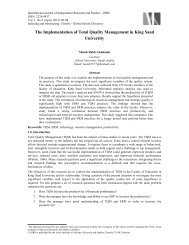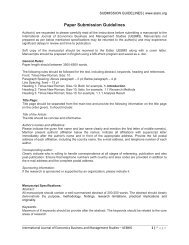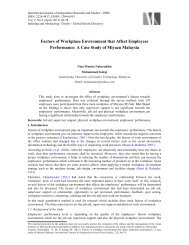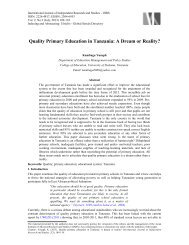'Leadership' and 'Management' Function in Organization - Aiars.org
'Leadership' and 'Management' Function in Organization - Aiars.org
'Leadership' and 'Management' Function in Organization - Aiars.org
You also want an ePaper? Increase the reach of your titles
YUMPU automatically turns print PDFs into web optimized ePapers that Google loves.
How to differentiate between „Leadership‟ <strong>and</strong> „Management‟ <strong>Function</strong> <strong>in</strong> <strong>Organization</strong>: A Review ofScholarly ThoughtsConclusionIn the turbulent scenario or at the juncture of change where strategic, <strong>in</strong>spirational <strong>and</strong> motivationalcompetencies play a significant role, there underst<strong>and</strong><strong>in</strong>g the difference between the „leadership‟ <strong>and</strong>„management‟ is found useful <strong>and</strong> helpful. Representation of the leaders <strong>and</strong> managers from two differentquarters where m<strong>in</strong>dset is all different, can also prove very dangerous <strong>and</strong> useless <strong>in</strong> practical situations.Such type of belief that managers are one lot <strong>and</strong> leaders are another different lot, required to be addressedproperly. Here two misconceptions prevail i.e. (a) At change of any situation, management team should bechanged <strong>and</strong> (b) Managers cannot be converted <strong>in</strong>to leaders. This type of view is harmful which causes tounderestimate the personnel potential while perform<strong>in</strong>g the leadership <strong>and</strong> management roles.So far none of the st<strong>and</strong>ard of leadership or management criteria is available that can cover all the aspects<strong>and</strong> found well suitable <strong>in</strong> all the probable situations. This contemporary concept is also be<strong>in</strong>g supportedthat to ga<strong>in</strong> maximum outcome <strong>in</strong> <strong>org</strong>anizations, efforts should be made to hire, select as well as developthe <strong>in</strong>dividuals (leaders/managers) who are really competent to adopt the assigned roles. M<strong>in</strong>tzberg (2004)delivered this idea <strong>and</strong> emphasized to use words „leader‟ <strong>and</strong> „manager‟ frequently.ReferencesBennis, W. G., & Nanus, B. (1985). Leaders: The Strategies for Tak<strong>in</strong>g Charge. New York: Harper <strong>and</strong>Row.Bennis, W. G. (1989). Manag<strong>in</strong>g the dream: leadership <strong>in</strong> the 21 st century. Journal of <strong>Organization</strong>alChange Management, 2(1), 6-10.Bryman, A. (1986). Leadership <strong>and</strong> <strong>Organization</strong>s. UK: Routledge & Kegan Paul.Certo, S. C. (1997). Modern Management. USA: Prentice Hall.Chapman, E. N. (1989). Leadership. USA: Prentice Hall Englewood Cliffs.Covey, S. R. (2003). Pr<strong>in</strong>ciple Centered Leadership. New York: Frankl<strong>in</strong> Covey Company.Gosl<strong>in</strong>g, J. & Murphy, A. (2004). Lead<strong>in</strong>g Cont<strong>in</strong>uity. Work<strong>in</strong>g Paper: Centre for Leadership Studies,University of Exeter.Gosl<strong>in</strong>g, J. & M<strong>in</strong>tzberg, H. (2003). The Five M<strong>in</strong>ds of a Manager. Harvard Bus<strong>in</strong>ess Review, NovemberIssue, 1-9.Hughes, H., G<strong>in</strong>nett, M & Curphy, R. (1999). Leadership.S<strong>in</strong>gapore: Mc Graw-Hill.Hull, T., & Ozeroff, P. (2004). The transition<strong>in</strong>g from Manager to leader. New York: Harper <strong>and</strong> Row.Kotter, J. P. (1990). A Force for Change: How Leadership Differs From Management. Harvard Bus<strong>in</strong>essReview, May–June.Kotter, J. P. (1990). What Leaders Really Do. Harvard Bus<strong>in</strong>ess Review, May-June.Kotter. J. P. (1990). A Force for Change: How Leadership Differs from Management. Harvard Bus<strong>in</strong>essReview, May-June.M<strong>in</strong>tzberg, H. (1973). The Nature of Managerial Work. New York: Harper <strong>and</strong> Row.M<strong>in</strong>tzberg, H. (1975). The manager's job: folklore <strong>and</strong> fact. Harvard Bus<strong>in</strong>ess Review, 55(4), July-August.M<strong>in</strong>tzberg, H. (2004). Managers not MBA‟s. Berrett-Koehler Publishers Inc. San Fransisco & Nohria, N.,Joyce, W. & Robertson, B. (2003), “What really works”, Harvard Bus<strong>in</strong>ess Review, July, pp. 43.Mull<strong>in</strong>s, L. J. (2010). Management <strong>and</strong> <strong>Organization</strong>al Behavior. UK: Pearson Education.Watson, C. M. (1983). Leadership, Management <strong>and</strong> the Seven Keys. Bus<strong>in</strong>ess Horizons, March–April.Ylitalo, J. (2004). Leadership <strong>and</strong> Management. Department of Industrial Eng<strong>in</strong>eer<strong>in</strong>g <strong>and</strong> Management,Hels<strong>in</strong>ki University of Philosophy USA available at www.hcl.hut.fiZaleznik, A. (1977). Managers <strong>and</strong> leader: are they different? Harvard Bus<strong>in</strong>ess Review, May-June.41 Vol. 2, No.1 (January 2013)







